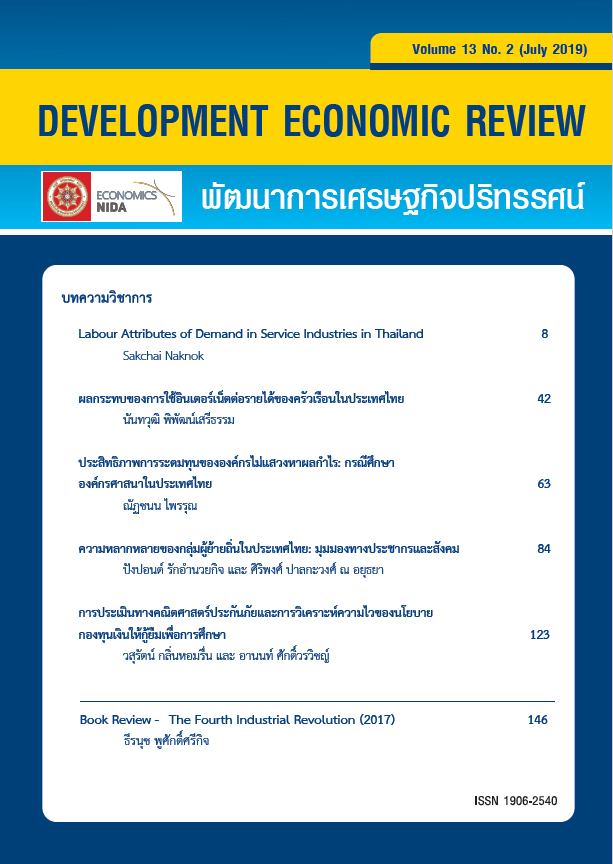The Impact of Internet Usage on Household Income: Evidence from Thailand
Keywords:
Internet Usage, Information and Communication Technology, Household IncomeAbstract
The purpose of this study is to analyze the impact of internet usage on households’ income in Thailand. Results indicate that internet usage has a significant positive impact on households’ income. When categorizing households’ income into three groups, including wage, non-agricultural income, and agricultural income, it is evident that the internet usage has positive impact on households’ wage and non-agricultural income but no impact on agricultural income. In addition, this study also analyzes the relationship between the impacts of internet usage and household’s characteristics. Results suggest that the internet usage has positive impact on wage only for households in which the household head has at least lower-secondary education. In addition, the adoption of internet also has a positive impact on wage only for households in non-municipal areas.
References
Czernich, N., Falck, O., Kretschmer, T., & Woessmann., L. (2011). Broadband Infrastructure and Economic Growth. The Economic Journal, 121(552), 505-532.
DiMaggio, P., & Bonikoski, B. (2008). Making Money Surfing the Web? The Impact of Internet Use on the Earning of U.S. Worker. American Sociological Review, 73, 227-250.
Gillett, S. E., & Sirbu, M. A. (2006). Measuring the Economic Impact of Broadband Deployment. Final Report submitted to the US Department of Commerce, Economic Development Administration. Retrieved from
https://cfp.mit.edu/publications/CFP_Papers/Measuring_bb_econ_impact-final.pdf
Goyal, A. (2010). Information, Direct Access to Farmers, and Rural Market Performance in Central India. Applied Economics, 2(3), 22-45.
Kolko, J. (2012). Broadband and Local Growth. Journal of Urban Economics, 71, 100-113.
Koutroumpis, P. (2009). The Economic Impact of Broadband on Growth: A Simultaneous Approach. Telecommunications Policy, 33, 471-485.
Qiang, C. Z., & Rossotto, C. M. (2009). Economic Impacts of Broadband. In 2009 Information and Communications for Development: Extending Reach and Increasing Impact. Washington DC: The World Bank.
Ritter, P. I., & Berreto, M. E. G. (2014). The Effect of Internet and Cell Phones on Employment and Agricultural Production in Rural Villages in Peru. Retrieved from https://pirhua.udep.edu.pe/handle/11042/1902
Shideler, D., Badasyan, N., & Taylor, L. (2007). The Economic Impact of Broadband Development in Kentucky. Regional Economic Development, Federal Reserve Bank of St. Louis, 3(2), 88-118.
Stenberg, M. M., Vogel, S., Cromartie, J., Breneman, V., & Brown, D. (2009). Broadband Internet’s Value for Rural America. United States Department of Agriculture, Economic Research Report No. 78. Retrieved from
https://www.ers.usda.gov/webdocs/publications/46200/9335_err78_1_.pdf?v=41056
Stigler, G. (1961). The Economics of Information. Journal of Political Economy, 69(3), 213-225.
World Development Report 2016: Digital Dividends. (2016). World Bank. Retrieved from https://www.worldbank.org/en/publication/wdr2016
Published
Issue
Section
License
Copyright to published manuscripts becomes the property of the Graduate School of Development Economics, National Institute of Development Administration. Reproduction of all or part of a Development Economic Review (DER) article by anyone, excluding author(s), is prohibited, unless receiving our permission.
Disclaimer: Opinions expressed in articles published in this journal are those of the author (s) and do nto necessarily represent opinions of the Graduate School of Development Economics, National Institute of Development Administration. Trade and proprietary names are only for identification and not constitute our endorsement.


